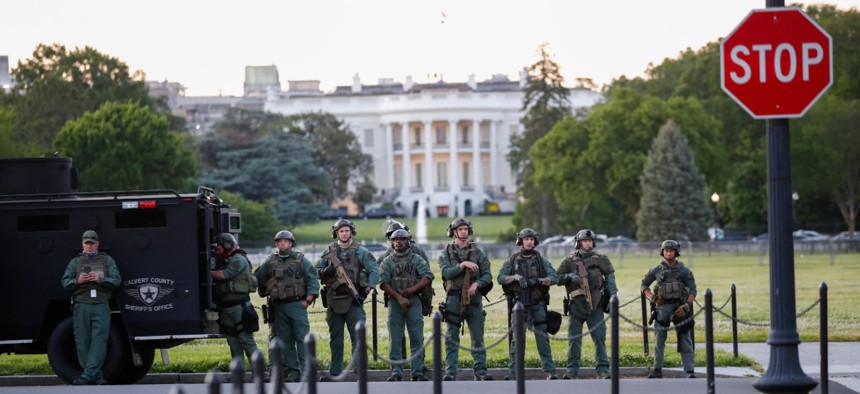
Alex Brandon / AP
Trump, GOP Allies Reach For Military Response To Domestic Protests
In startling language, Defense Secretary Mark Esper referred to American streets as “the battlespace.”
Updated: 11:21 p.m.
As police began firing tear gas to clear peaceful protesters away from an imminent presidential photo-op near the White House on Monday evening, President Donald Trump said he had ordered “thousands and thousands of heavily armed soldiers, military personnel, and law enforcement officers” to quell civil unrest in Washington, D.C., and threatened to deploy troops in states that “refuse” to do so in their own cities.
“I am your president of law and order and an ally of all peaceful protesters,” Trump said during brief remarks in the Rose Garden. “I have strongly recommended to every governor to deploy the National Guard in sufficient numbers that we dominate the streets.
“If a city or state refuses to take the actions that are necessary to defend the life and property of their residents, then I will deploy the United States military and quickly solve the problem for them.”
The president does not have the legal authority to deploy active duty troops to conduct law enforcement without invoking the 1807 Insurrection Act — which he did not do on Monday — and state governors quickly fired back on the announcement.
“I reject the notion that the federal government can send troops into the state of Illinois,” Illinois Gov. Jay Pritzker, a Democrat, said on CNN. “His rhetoric is inflaming passions around the nation. He should be calling for calm. He should be calling for bringing the temperature down. He’s doing the exact opposite.”
The Pentagon has ordered an active-duty battalion of military police officers from Fort Bragg, N.C., to Washington, “in standby capacity,” according to reporting from Military Times and others. And as protesters and police continued to gather in various locations in the capital well past Mayor Muriel Bowser’s 7 p,m. curfew, one or more military helicopters flew low over the crowds and Joint Chiefs Chairman Gen. Mark Milley, dressed in his Army combat uniform, assessed the National Guard presence.
Throughout the day on Monday, Trump, his administration officials, and conservative lawmakers urged a military response to civil unrest and protests gripping American cities across the country, using the unambiguously belligerent rhetoric of war to describe the chaos sparked by the killing of a black man by a white police officer in Minnesota last week.
Trump endorsed a call from Sen. Tom Cotton, R-Ark., to deploy the 101st Airborne and other famed military units to “face off” with Antifa, a far-left anarchist movement that the president has sought to blame for the violent unrest, tweeting “100% correct!” Cotton called for the group to be given “no quarter” — a military term that means that captured members of a foreign force will be killed. Rep. Matt Gaetz, R-Fla., suggested that U.S. forces should “hunt [Antifa] down like we do [terrorists] in the Middle East.” Defense Secretary Mark Esper called for authorities to “dominate the battlespace,” a reference to U.S. streets where the protests and riots are taking place.
"I think the sooner that you mass and dominate the battlespace, the quicker this dissipates and we can get back to the right normal,” Esper said during a White House call with state governors that preceded Trump’s Rose Garden appearance. (Audio is here.)
Meanwhile, tens of thousands of National Guardsmen have been called up in cities across the country to support local law enforcement’s response to the unraveling crisis. Guardsmen have been involved in at least two shootings nationwide, one of which was fatal, in Louisville, Ky.
And in a vague proclamation during the White House call, Trump said that he had put Milley “in charge” of managing the racial unrest sweeping the country. At a briefing later in the day, Press Secretary Kayleigh McEnany declined to offer any details about Milley’s role or explain why a military official would be placed in charge of a domestic law enforcement issue. Pentagon officials have not commented or offered further explanation of Milley’s potential role.
“Just allow freedom to assemble, and freedom of speech. That’s perfectly fine, we support that,” Milley said on the street Monday evening, asked by a reporter what message he wanted to convey. “We took an oath of allegiance to the Constitution of the United States of America to do that, to protect everyone’s rights, that’s what we do.”
The Trump administration response has deeply unnerved scholars of civil-military relations, many of whom note that the military is forbidden under the 1878 Posse Comitatus Act from practicing domestic law enforcement unless explicitly authorized by statute. If the president invokes the Insurrection Act, which stipulates that the president determine “as a result of a natural disaster [that] domestic violence has occurred to such an extent that the constituted authorities of the State or possession are incapable of maintaining public order,” he could use both federalized National Guard troops and regular military forces for law enforcement purposes. But critics say that further militarizing the government’s response will only inflame tensions and heighten policing disparities that spurred the unrest in the first place.
“The domestic deployment of our armed services is an incredibly serious undertaking that should not be taken lightly,” said House Armed Services Committee Chairman Adam Smith, D-Wash., in a statement. “It is un-American to use our service members to ‘dominate’ civilians, as both the President and Secretary of Defense have suggested. We live in a democracy, not a dictatorship.”
“The ‘battle space’ of America???” tweeted Tony Thomas, who commanded U.S. Special Operations Command during the Trump administration before retiring as a four-star. “Not what America needs to hear...ever, unless we are invaded by an adversary or experience a constitutional failure...ie a Civil War…”
“This is nuts,” said Dave Lapan, retired Marine Corps colonel who served as top spokesman for the Pentagon, Joint Chiefs of Staff, and the Marine Corps, under President Barack Obama, and as Department of Homeland Security spokesman alongside retired Gen. John Kelly, under Trump. “Beyond the idea that an active duty military officer would be ‘in charge of’ domestic law enforcement actions, the Chairman of the [Joint] Chiefs of Staff commands no troops. He is senior military advisor to the President and Secretary of Defense.”
“Cotton is 100% wrong on this and so is POTUS. (SecDef too in referring to American cities as battle space),” Lapan added.
Cotton’s call for Antifa protesters to be given “no quarter” also drew outrage.
“Today, June 1, 2020, Harvard Law graduate and US Senator @SenTomCotton called for the deployment of battle hardened US Army combat units to America’s burning cities with shoot to kill orders. He wants the US Army to kill Americans,” tweeted GOP strategist Steve Schmidt. “Cotton is a dangerous man. Radical and illiberal.”
An aide for Cotton, Tom Noonan, pushed back on critics on Twitter, calling Cotton’s use of the term “an obvious exaggeration for affect” [sic] and calling responses like Schmidt’s “escalatory rhetoric.”
The protests, unrest and rioting across the country has been marked by violence by both protesters — including looting and setting fire to police cars and other installations — and police, who have been filmed beating and kicking protesters, often with what appears to be disproportionate force. Reporters covering the demonstrations have been shot with rubber bullets, sprayed with tear gas, arrested, and physically assaulted by police.
The demonstrations have continued to burn across the country, even following the arrest of Derek Chauvin, the Minneapolis police officer charged with the murder of George Floyd. Chauvin was filmed kneeling on Floyd’s neck for more than eight minutes before he died. A family-direct autopsy said Floyd died by homicide from asphyxiation.
The presence of different groups of protesters, with violent demonstrators mixing with many who are protesting nonviolently, has complicated the politics surrounding the movement. The Department of Homeland Security warned in an intelligence memo to law enforcement officials that anarchists and militia groups could try to “exploit” legitimate First Amendment-protected protests, according to Politico.
Famed civil rights leader Rep. John Lewis, D-Ga., urged “rioters” to protest peacefully.
“To the rioters here in Atlanta and across the country: I see you, and I hear you,” he said in a statement on Sunday. “I know your pain, your rage, your sense of despair and hopelessness. Justice has, indeed, been denied for far too long. Rioting, looting, and burning is not the way. Organize. Demonstrate. Sit-in. Stand-up. Vote. Be constructive, not destructive. History has proven time and again that non-violent, peaceful protest is the way to achieve the justice and equality that we all deserve.”
On Monday, Obama published an article on Medium condemning those turning to violence. “Let’s not excuse violence, or rationalize it, or participate in it.” The former president called for police and criminal justice reforms.
Some Democratic lawmakers have called for new restrictions on a program that provides surplus military equipment to local police departments. Obama put a halt to the so-called 1033 program in 2015 after images of heavily armed police responding to protests in Ferguson, Mo., shocked the nation; Trump reversed the ban upon taking office in 2017.
Trump and other Republicans have sought to pin the convulsive protests on Antifa — Trump said the U.S. would officially designate them a “terrorist organization,” a legal impossibility — calling on state governors to use force to crack down on the demonstrations. Trump on Monday said that Walz’s original response to unrest in Minneapolis was “weak and pathetic,” but praised him for calling up the Guard. The Guard’s response was “domination,” Trump said. “It couldn’t be any better. It was a beautiful thing to watch.”
Antifa is a loosely organized group that does not make its membership rolls public, making the scope of its involvement in the looting and other violent elements of the protests difficult to assess. But thousands of people nationally have been involved in some capacity, and the protests are far larger and more diverse than a single group.
On May 1, amid a spate of protests against coronavirus restrictions in cities across the country, Trump praised armed protesters who stormed the Michigan state capitol building.
Those protesters, Trump said, “are very good people, but they are angry. They want their lives back again, safely!”







